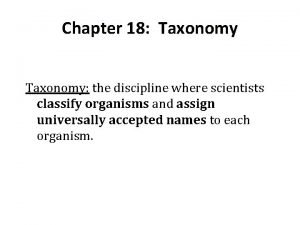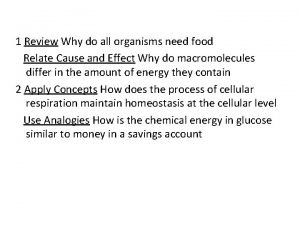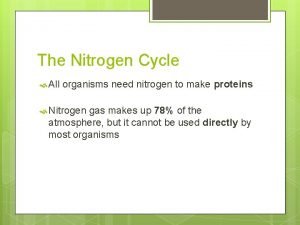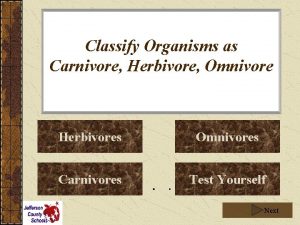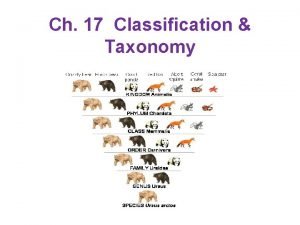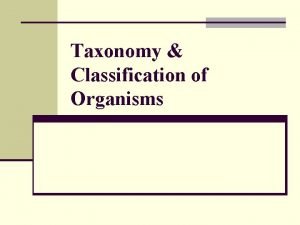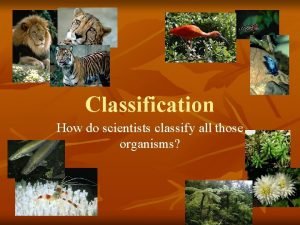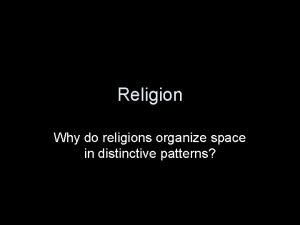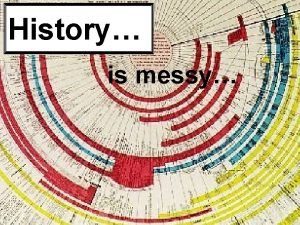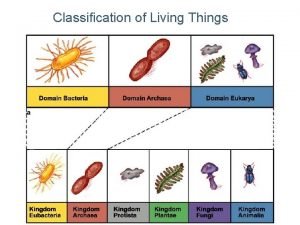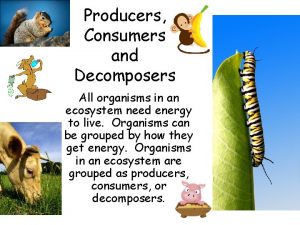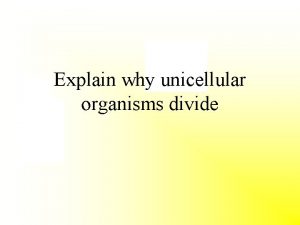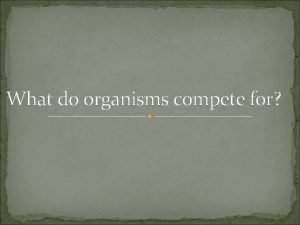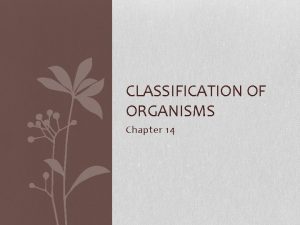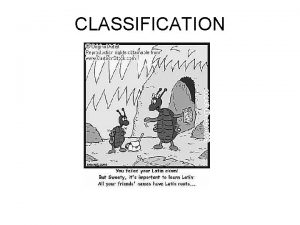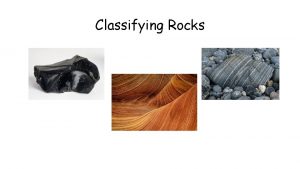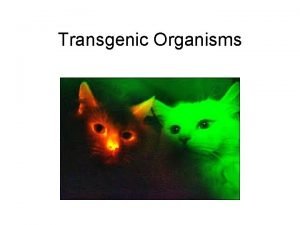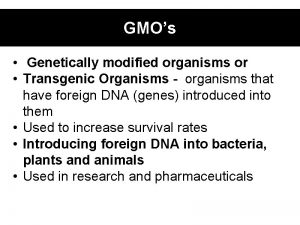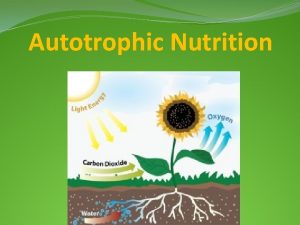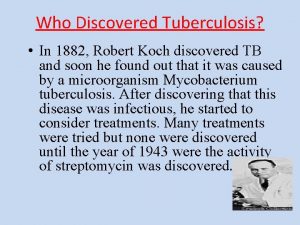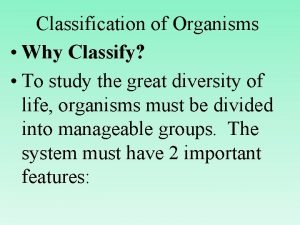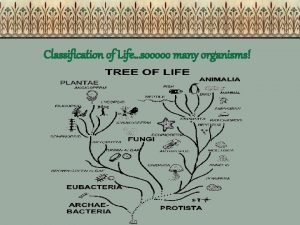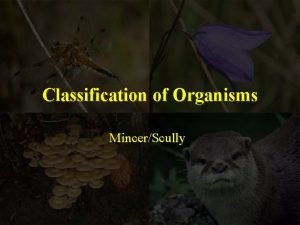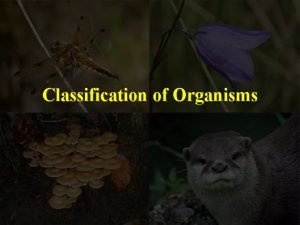Why classify To organize all the discovered organisms


















































- Slides: 50

Why classify? • To organize all the discovered organisms • To give organism a standard name so scientists from different countries can talk about the same animal without confusion

Who is Carlous Linnaeus? • Carolus Linnaeus was a Swedish botanist • Developed a classification system based on similarities between organisms (plants/animals) • Today we use an seven level system to classify living things

6 Kingdoms of Life

All organisms are classified into one of the following 6 kingdoms. 1. Archaebacteria – bacteria that live in harsh conditions 2. Eubacteria – bacteria that live in normal conditions 3. Protista – organisms made of one eukaryotic cell 4. Fungi – mushrooms and molds 5. Plantae – all plants including trees, bushes, and flowers 6. Animalia – all animals including insects

• The grouping of organisms into KINGDOMS is based on 3 factors: – 1. Cell type – 2. Cell number – 3. Feeding Type – 4. Reproduction Notice these are four of the categories at the top of your chart.

1. Cell Type- The presence or absence of a nucleus. Prokaryotes (NO nucleus) & Eukaryotes (DO carry a nucleus)

2. Cell number - Whether the organisms are made of single cells or many cells • Unicellular- single celled organism • Multicellular- many celled organism

• Unicellular • Multicellular

3. Feeding Type - How the organisms get their energy 0 r food. *Producer (Autotroph) • Makes it’s own food *Consumer (Heterotroph) Must eat other organisms to survive

3. Reproduction Type - How the organisms produce offspring *Asexual : One parent • Binary Fission • Fragmentation • Budding *Sexual: Two Parents

As you go through the Power. Point Fill in the chart with the correct information about each of the 6 kingdoms. Remember for each kingdom your want to find: 1. Cell Type – Prokaryotic OR Eukaryotic 2. Cell Number – Unicellular AND/OR Multicellular 1 3. Feeding Type – Producer (Autotroph) OR Consumer (Heterotroph) 4. Reproduction Type- Asexual OR Sexual Some interesting facts about that kingdom

6 Kingdoms • • • Archaebacteria Eubacteria Protista Fungi Plantae Animalia Prokaryotes Eukaryotes

First Two Kingdoms • The first two kingdoms involve bacteria. Scientists at one time grouped bacteria into one kingdom but just recently divided them into two groups: Archaebacteria and Eubacteria • Both groups of bacteria are prokaryotes and unicellular

Kingdom 1: Archeabacteria • CELL TYPE: PROKARYOTE • CELL NUMBER: UNICELLULAR • FEEDING HABIT: : PRODUCERS/AUTOTROPHS OR DECOMPOSERS( HETEROTROPHS) • REPRODUCTION: ASEXUAL

Archaebacteria • Archaebacteria is also called ancient bacteria as they date back 4 billion years – They are found in harsh environments that no other organism lives. We call them “heatloving” or “salt-loving” or “Methane-loving” – The yellow and orange rings around the hot springs in Yellowstone National Park were formed by the remains of archaebacteria billions of years ago!

Archaebacteria – Gets energy from sunlight (producer/autotroph) – Breaks down things in dead or decaying organisms (decomposer/heterotroph) – Asexual reproduction by binary fission – Reproduces in a short amount of time – Different chemical makeup than bacteria

Eubacteria • It is the eubacteria that most people are talking about when they say bacteria, because they live in more normal conditions like the human body or pond water.

Kingdom 2: Eubacteria • • • Cell type: prokaryote Cell number: unicellular Feeding habit: producers/autotrophs OR decomposers/heterotrophs Reproduction: asexual

Bacterial Locomotion • Some bacteria have flagella or cilia for movement • Some secrete a slime layer and ooze over surfaces like slugs

Uses of bacteria We would not have yogurt or cheese if it was not for bacteria! Cleaning solutions and some medicines are also made from specific types of bacteria. They also are decomposers and help with the nitrogen cycle. • 99% of bacteria is helpful and only 1% is harmful causing diseases such as tuberculosis and diphtheria.

Kingdom 3: Protists • Cell type: eukaryote • Cell number : unicellular or multicellular • Feedinghabit: producer or consumer or decomposer • Reproduction: mostly asexual but sometimes sexual

Protists • Most diverse Kingdom • There animal-like, fungus-like, and plant-like protists (the left-overs) • Some are beneficial • Protists are found in lakes and ponds • Some protists can cause diseases in humans, such as:

Protists Disease • Amebic dysentery Ameba histolytica

Protists Disease • African Sleeping Sickness Trypanosoma

Protists Disease • Malaria kills about one million people every year! Plasmodium

Protists Movement • 3 types of movement: – Pseudopod (false foot) – Flagella/cilia (hairs) – Contractile vacuoles

Kingdom 4: Fungi • The Kingdom Fungi includes some of the most important organisms. • By breaking down dead organic material, they continue the cycle of nutrients through ecosystems.

• Cell type: eukaryotic • Cell number: unicellular or multicellular • Feeding habit: decomposer • Reproduction: Asexual or sexual reproduction Fungi Unicellular (yeast) Multicellular

Fungi • Fungi can be very helpful and delicious • Many antibacterial drugs are derived from fungi Penicillin

Fungi • Fungi also causes a number of plant and animal diseases: • Athlete's Foot

• Ringworm Fungi

Fungi Movement • Fungi are stationary • They have root-like structures that they use for attachment

Kingdom 5: plants • • Cell type : eukaryotic Cell number: multicellular Feeding habit: producers Reproduction: asexual and sexual

• Mosses

• Liverworts & Hornworts

• Ferns

• Conifers (cone bearing) – Gymnosperms • Oldest vascular plants

• Flowering plants – Angiosperms

Kingdom 6: Animalia Cell type : Eukaryotic cells. Cell number: multicellular feeding : heterotrophs / consumers Reproduction: sexual

• Porifera: sponges

• Cnidarians: Jellyfish, corals, and other stingers. . . Their stinger is called a nematocyst

• Nematocyst

• Mollusks – Octopi, squid – Clams, oysters – Snails, slugs

• Platyhelminthes (flat worms) – Tapeworms & flukes Human liver fluke

• Annelids (segmented worms) – Worms & leeches

• Echinoderms – Starfish, sea urchins, sea cucumbers

• Arthropods – Shell fish, arachnids & BUGS!

• Chordates – The Chordata is the animal phylum with which everyone is most familiar, since it includes humans and other vertebrates.

Now That you are familiar with the 6 Kingdoms of Life, complete your thinking map by putting the title of the kingdom and some illustrated examples of organisms that belong to that kingdom in each box. You can go back through the slides for examples and/or use the following slide.

 Why do scientists classify organisms?
Why do scientists classify organisms? Why do scientists classify
Why do scientists classify Why do organisms interact with other organisms
Why do organisms interact with other organisms Hey hey bye bye
Hey hey bye bye Why do all organisms need food
Why do all organisms need food Why do organisms need nitrogen?
Why do organisms need nitrogen? Classify the organisms as herbivore or carnivore.
Classify the organisms as herbivore or carnivore. Classification groups in order
Classification groups in order Carolus linnaeus
Carolus linnaeus How do scientists classify organisms
How do scientists classify organisms Unicellular vs multicellular
Unicellular vs multicellular Why do religions organize space in distinctive patterns
Why do religions organize space in distinctive patterns Why do historians organize history chronologically?
Why do historians organize history chronologically? Name 3 points
Name 3 points Dont ask
Dont ask Why do we classify things
Why do we classify things Why isn't it a good idea to classify matter by its phases
Why isn't it a good idea to classify matter by its phases Protistq
Protistq Consumer to decomposer
Consumer to decomposer Where do all organisms get their energy
Where do all organisms get their energy What is the smallest living unit in all organisms?
What is the smallest living unit in all organisms? Why unicellular organisms divide
Why unicellular organisms divide Why do organisms compete
Why do organisms compete Emergent properties
Emergent properties Hát kết hợp bộ gõ cơ thể
Hát kết hợp bộ gõ cơ thể Slidetodoc
Slidetodoc Bổ thể
Bổ thể Tỉ lệ cơ thể trẻ em
Tỉ lệ cơ thể trẻ em Chó sói
Chó sói Tư thế worm breton là gì
Tư thế worm breton là gì Chúa yêu trần thế alleluia
Chúa yêu trần thế alleluia Các môn thể thao bắt đầu bằng tiếng nhảy
Các môn thể thao bắt đầu bằng tiếng nhảy Thế nào là hệ số cao nhất
Thế nào là hệ số cao nhất Các châu lục và đại dương trên thế giới
Các châu lục và đại dương trên thế giới Cong thức tính động năng
Cong thức tính động năng Trời xanh đây là của chúng ta thể thơ
Trời xanh đây là của chúng ta thể thơ Mật thư anh em như thể tay chân
Mật thư anh em như thể tay chân Làm thế nào để 102-1=99
Làm thế nào để 102-1=99 Phản ứng thế ankan
Phản ứng thế ankan Các châu lục và đại dương trên thế giới
Các châu lục và đại dương trên thế giới Thể thơ truyền thống
Thể thơ truyền thống Quá trình desamine hóa có thể tạo ra
Quá trình desamine hóa có thể tạo ra Một số thể thơ truyền thống
Một số thể thơ truyền thống Cái miệng xinh xinh thế chỉ nói điều hay thôi
Cái miệng xinh xinh thế chỉ nói điều hay thôi Vẽ hình chiếu vuông góc của vật thể sau
Vẽ hình chiếu vuông góc của vật thể sau Biện pháp chống mỏi cơ
Biện pháp chống mỏi cơ đặc điểm cơ thể của người tối cổ
đặc điểm cơ thể của người tối cổ Giọng cùng tên là
Giọng cùng tên là Vẽ hình chiếu đứng bằng cạnh của vật thể
Vẽ hình chiếu đứng bằng cạnh của vật thể Vẽ hình chiếu vuông góc của vật thể sau
Vẽ hình chiếu vuông góc của vật thể sau Thẻ vin
Thẻ vin
